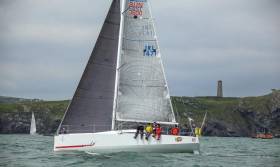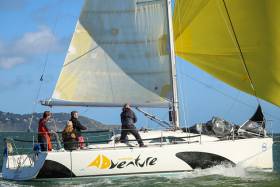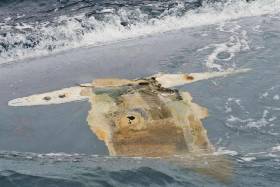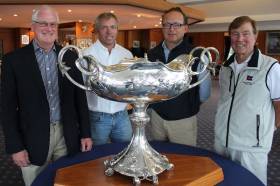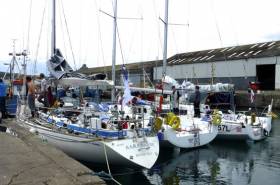Displaying items by tag: Offshore
Bam! Ready for the Final Push in Middle Sea Race, Winner Announced By Royal Malta YC
Howth Yacht Club Middle Sea Race entry BAM has been drifting/running past Lampedusa towards the general direction of Malta/Turkey hoping for a forecasted swing and an increase in the breeze reports Anthony Doyle onboard the Dublin-based Jeanneau 3600.
The last 48 hours have been frustrating in that we made up a lot of ground across the northern coast of Sicily only to sail into another wind hole at Capo San Vito, the other side of which 2 miles away had 25ktns waiting for us.
Once we did make it through 3 hours later the lead boats in our class had disappeared again, we quickly stuck a reef in and changed down to the number 4 head sail as the breeze built from 3 Ktns to 30 Ktns in a matter of minutes. We spotted Otra Vez on the AIS heading back to Sicily and assumed that she had suffered gear failure, at least we were still in the race - there is always a positive.
Wrapped another lobster pot around the keel last night, sails down for 45 mins again to remove it.
Some highlights of the race so far
- seeing Stromboli erupting at night
- pot noodles, the "Bombay Bad Boy" went down well, "Mac and Cheese" not so much
- freeze dried dinners, chicken in black bean was especially good
- hot dogs
- being warm on the rail even when wet, makes a bit of a difference to ISORA racing
Downsides
- 1st and 2nd lobster pots on the keel resulting in dropping all sails and one of the young lads having to dive down to cut them off. Never seems to happen during the day....
- wind holes
- more wind holes
- even more wind holes
Crew are in good form, boat has been going well once we get some breeze, unfortunately the weather gods have been kinder to others this time around.
Thought for the day, "Sheep tails go down and Goat tails go up"....
Now for the final push...
Meanwhile, the Royal Malta Yacht Club announced that Vincenzo Onorato's Cookson 50 Mascalzone Latino is the overall winner of the 37th Rolex Middle Sea Race. Whilst a number of yachts are still racing, none of them have the possibility of beating Mascalzone Latino's corrected time. The Mascalzone Latino team will be awarded the Rolex Middle Sea Race Trophy and Rolex timepiece on Saturday 29 October at the prize giving ceremony to held at the Mediterranean Conference Centre in Valletta.
 Middle Sea Race winner – Mascalzone Latino Photo Rolex/Kurt Arrigo
Middle Sea Race winner – Mascalzone Latino Photo Rolex/Kurt Arrigo
This race crew was a mix of Italians and British sailors who have raced all over the world under the Mascalzone Latino banner and with great success. Last year they came agonizingly close to adding the Rolex Middle Sea Race to the honour role. In the absence of owner, Vincenzo Onorato, the boat was skippered this year by Matteo Savelli. The afterguard included Adrian Stead, Lorenzo Bressani and Branko Brcin. Ian Moore was the navigator. The sail trimmers were Leonardo Chiaruigi, Pierluigi De Felice, Stefano Ciampalini and Andrea Ballico. Daniele Fiaschi and Davide Scarpa shared the bowman duties.
Matteo Savelli: “Twelve months ago we cherished the possibility of victory but it was not to be by a nine seconds gap. But our belief in success at this event was simply delayed until this year. And now, we can say we couldn’t expect more. Everything has worked properly and the job went off without a hitch. The crew commitment was remarkable; the only regret was the lack of Vincenzo Onorato onboard."
The 2016 Rolex Middle Sea Race will be marked in the ever growing race legend as a tactically demanding one, with huge pressure on the tacticians and navigators to keep the yachts moving in the face of changing conditions. “It felt like unfinished business after coming so close to winning last year,” commented Ian Moore, continuing, “but past performance is no guarantee of future success! We knew if we wanted a chance to win this race that we would have to sail really well and get a little bit lucky with the weather. In the end, our luck held, and the guys sailed really well despite tough conditions.”
Vincenzo Onorato of Mascalzone Latino: “I am really very happy for this victory. We have quite the same crew for many many years. We won together six Worlds titles, I can’t remember how many Europeans and many of the most important major regattas in the world. The Rolex Middle Sea Race is the pinnacle of offshore racing in the Med. We were looking to win for a long time and finally we have proudly succeeded”.
One Irish boat and a good selection of Irish sailors are among 112 twelve boats, from twenty five nations and six starts in tomorrow's Middle Sea Race. A light wind forecast means that it may suit smaller boats rather than the big yachts, including the sole north Dublin entry.
Conor Fogerty's BAM, a Sunfast 3600, races in division IRC six with a full Howth Yacht Club crew including Simon Knowles, Paddy Gregory, Sam O'Byrne, Rob Slater and Anthony Doyle. As Afloat.ie readers will recall, the doughty Irish offshore campaigner took a class win in February's RORC Caribbean 600 race.
Fogerty arrived into the Grand Harbour in Valletta last Tuesday. In the last 12 months, Bam has been sailed from Howth to the Canaries, then did the ARC race to St Lucia, then the Caribbean 600 race in February, then Conor sailed solo to the Azores, delivery from Azores back to Howth, then the Round Ireland Yacht race in June, then to the Solent for the Fastnet solo race, then the new RORC IIe D’Ouessant Race, then the Cowes to Cherbourg race and just now a delivery from Southampton to Malta. After the Middle Sea race, the boat will be wintered ashore in Malta until next spring year when she returns home.
Organised by the Royal Malta Yacht Club, the 2016 Rolex Middle Sea Race will start at 11:00hrs (CET) on the 22nd October in the spectacular Grand Harbour, Valletta, Malta.
ISORA sailors Liam Coyne and Brian Flahive are back onboard the Maltese J122 Otra Vez skippered by owner Aaron Gatt Floridia, who has sailed in Ireland's Dun laoghaire to Dingle race. It will be Coyne's fourth Middle Sea on Otra Vez. 'This will be my seventh Middle Sea race and really feeling good about this one' Coyne told Afloat.ie. Coyne managed a class win in 2014 and has previously been sixth time overall.
Also racing is INSS sailor Kenneth Rumball as part of a Maltese crew onboard the Xp44, Xpact. Rumball previously raced on Xpact in 2014 with other Irish sailors Andy Boyle, Philip Connor and Barry Hurley to second overall and first in class three onboard this X-Yacht. Hurley is back on board this year and joining them is Shane Divney of Howth Yacht Club coming back from GC32 Circuit. Laura Dillon of HYC is on Winsome. Dublin's Conor Kinsella, a co-skipper on Lynx in this year's Round Ireland, is sailing on Xpedite.
London–based Royal Irish Yacht Club sailor Niall Dowling is listed on the crew of Pata Negra, the Lombard 46 skippered by Giles Redpath
The 608-mile yacht race takes place in the heart of the Mediterranean and covers one of the most beautiful courses in the world. Starting and finishing in Malta, the route includes the deep azure waters around Sicily including the Aeolian and Egadi Islands, as well as Pantelleria and Lampedusa. One of the most stunning vistas is Stromboli, the active volcano which is a course mark.
Challenging, enchanting and historic, the annual Rolex Middle Sea Race is one of Europe’s most popular and respected offshore races. Supported by Rolex since 2002, the event’s fascination is largely drawn from its alluring, 608-nautical-mile race course – a rigorous and scenic anti-clockwise loop around Sicily, which introduces numerous ‘corners’ that present changing and complex meteorological shifts.
ISORA Surveys Sailors for 2017 As Irish Sea Fleet Hits 54 Yachts
Offshore sailing body ISORA that goes from strength to strength on the Irish Sea, with 54 boats racing in 2016, is surveying competitors in an on-line questionnaire for competitors (past, present and future) to make sure it is 'providing the racing that will inspire and excite existing and future sailors' whilst keeping within the ISORA ethos.
ISORA chief Peter Ryan says this is ''particularly important now that the fleet is growing with a wide variety of types and sizes of boats'. ISORA, Ryan says, is also 'aware of the need for a forum for suggestions and opinions bearing in mind that the owners and competitors are from all corners of the Irish Sea'.
ISORA has embraced cutting edge of modern race management techniques this season with a world first for a virtual start on Dublin Bay and it is something ISORA wishes to develop 2017.
Competitor boats are located in many ports in Ireland, Wales, Isle of Man and England and consequently competitors, crew and skippers will not have many opportunities to share their thoughts and ideas for offshore and coastal racing in the Irish Sea catchment area.
In framing the survey (see link below) the race organisers are considering the different boat types and varying boat sizes competing in ISORA races with IRC numbers ranging from 1.152 to 0.831 – the equivalent of 16 minutes in an hour or almost 7 hours in a 24–hour race!
Despite this ISORA are expected to deliver fair racing where each competitor has a real chance of winning. ISORA has attempted to provide this by applying appropriate class splits and fleets not only arranged by size (IRC) but by type. 'We now need to know if the Class structure is correct and will be relevant to the competitors in 2017' says Ryan.
Take the survey here
Manslaughter Charges For Yachting Boss Over ‘Cheeki Rafiki’ Deaths
#CheekiRafiki - The director of a yachting company has been charged with manslaughter after the loss of four British sailors when their vessel capsized in the Atlantic two years ago.
As Sky News reports, Douglas Innes of Stormforce Coaching Ltd faces four counts over the deaths of James Male, Andrew Bridge, Steve Warren and Paul Goslin when the Cheeki Rafiki lost its keel some 700 miles off Nova Scotia in May 2014.
The four experiences offshore sailors had been returning to Britain from a regatta in Antigua when the tragedy occurred, as previously reported on Afloat.ie. None of the four were recovered.
Now the UK’s Crown Prosecution Service has brought charges against Innes, head of the company responsible for maintaining the 40ft yacht, following an extensive investigation into the incident by the Maritime and Coastguard Agency.
The Marine Accident Investigation Branch report is available online, and Sky News has more on the story HERE.
Howth Skipper Fogerty Eyes RORC IRC Prize
Having taken a substantial fifth place in the weekend's RORC Cowes to Cherbourg offshore race following on from the early season good showing in the Caribbean 600, Round Ireland and Ile D'Ouessant races, lines Conor Fogerty and the BAM crew are nicely positioned for a top three finish in the RORC IRC 3 2016 points championship.
Crew for the Cowes Cherbourg race were Conor Fogerty (Helm), Simon Knowles (Helm/Tactics), Paddy Gregory (Helm/Main Trimmer), Conor O'Neill (Main /Jib Trimmer), Julian Brexit (Trimmer), Anthony Doyle (Navigation/Bow/).
The HYC skipper and the crew took particular satisfaction in being the first Sunfast 3600 home and on IRC while also finishing ahead of a number of coveted JPK1080 yachts.
The next big outing for Fogerty and the BAM crew is the Rolex Middle Sea Race in October.
ISORA Offshore Sailing Season Hangs on Pwllheli to Dun Laoghaire Race
There are some familiar names at the top of the ISORA 2016 leaderboard that should produce a cliff hanger finish off Dun Laoghaire on September 10th. J109s fill the top three places and J Boats the top five overall. Former champion Sgrech skippered by Stephen Tudor from Pwllheli leads on 525.7 points, club mate Peter Dunlop is second on 520 points with defending champion Ruth (Liam Shanahan) in third place on 518.2 points.
The next and final race in the ISORA Averycrest 2016 Series is Race No. 12 from Pwllheli to Dun Laoghaire. 25 boats are already entered and in an exciting conclusion, the Irish offshore season is still all to play for. This race will decide the winner of Class 2, Class 1, The Silver class and the overall championship for the Wolf's Head. The results up to and including race 11 are available here.
RORC's Race to France is Penultimate Points Race of 2016
The penultimate race of the RORC Season's Points Championship often has a party atmosphere, it is the last race of the RORC season in English and French waters. About seven hundred sailors will be making the dash to France, in a variety of yachts racing under the IRC Rating system, and under the Class40 Rule. For some classes, the RORC Cherbourg Race is the season decider, for others who are already assured of class wins, there is the opportunity to race and celebrate in Cherbourg.
In IRC Zero, the duel between Piet Vroon's Dutch Ker 51 Tonnerre 4 and Avenarius & Gondesen's German Ker 46 Shakti will come to a conclusion. Neither will be taking part in the final race of the series, the Rolex Middle Sea Race. Shakti leads Tonnerre by over 30 points, and the German team will only need to finish the race to be sure of victory for the season. The IRC Zero fleet for the Cherbourg Race also includes other fast downwind flyers; Farr 52 Bob, Ker 46 Lady Mariposa and Class40 Arwen.
In IRC One, Nick Jones' First 44.7, Lisa is likely to win both the class and the RORC Season's Points Championship overall, if the team can successfully finish the race. Alan Hannon's RP45 Katsu poses the biggest threat to Lisa. Past RORC Commodore, Mike Greville racing Ker 39 Erivale III has an outside chance of winning the class, but may well be focused on holding off a strong challenge from Edward Broadway's Ker 40 Hooligan VII.
With two weddings, a school, the British Army, and a virtual photo finish. Fact is stranger than fiction in IRC Two. The British Army Sailing Association's J/111 British Soldier, is just 0.2 of a point ahead of Sailing Logic's First 40, Arthur Logic, which tops the class. Ross Applebey's Oyster 48 Scarlet Oyster, could have moved from third to first, but Ross will be getting married this weekend. Chris Frost & Elin Haf Davies, who have been racing J/120 Nunatak, tied the knot last weekend, and will interrupt their honeymoon to join the action, but the result will come down to a four way shoot out between Sailing Logic’s Arthur Logic, the British Army’s, British Soldier, Nunatak and Gilles Fournier’s, J/133,Pintia which has not been beaten in class this year.
“We have two of our First 40s - Arthur and Rocket Dog II - in this end of season shoot out and we are thoroughly looking forwards to it” commented Sailing Logic's Prue Nash. “Just about everyone who has been racing with us this year has been trying to get on the crew list for one last chance to beat British Soldier! The J/111 crew are a strong bunch of sailors and the Sailing Logic crews, together with skippers Olz Heer and Richard Oswald, have really enjoyed pitting their wits against them this season – may the best man win!”
“We are bracing ourselves for a seriously competitive and intense sprint across the channel” commented Captain Phil Caswell of the British Army Sailing Association. “Arthur Logic is sailing very well at the moment, so we know it will be very tough to hold on to a lead. It will also be a special race, as it will be our last on the J/111, before we look to replace her for next season. We’ll be bringing the A-Team, and in terms of strategy we’ll stick to the tried and tested squaddy proof method - sailing her like we stole her! Failing that the promise of French steak and red wine is always an excellent motivator to get there in good time.”
“Scarlet Oyster has never won class in the RORC offshore season and we won't be this year” commented Scarlet Oyster's Ross Applebey. “We already had a clash this weekend as my fiancée, Sarah, owns a Contessa 26 and the nationals is the same weekend. So to solve the problem, we decided to miss both, and get married. We will be back RORC racing in the RORC Caribbean 600 next year.”
In IRC Three, Delamare & Mordret's JPK 10.80 Dream Pearls leads the class by just 7.6 points, the team from St Malo will have a terrific battle with Louis-Marie Dussere's JPK 10.10 Raging Bee, who will be racing into their home port of Cherbourg. Raging Bee has all but secured the IRC Two Handed Class, but would love to add IRC Three for a fairy tale finish at the Yacht Club de Cherbourg. RORC Racing Manager Nick Elliott, will be giving up desk duties to race on JPK 10.80 Audrey, skippered by RORC Commodore's Michael Boyd.
“I have not managed to do an offshore race since joining the RORC as Deputy Racing Manager in 2008, as I have either been involved in the organisation of them or had other commitments” commented Nick Elliott. “For the race I am imagine my position will be tea boy, as it has been a while since I have been further than around the Isle of Wight. Janet Grosvenor is looking after the start and James Bremridge will be greeting us at the finish. So I am not involved in the race management until Prizegiving. The Cherbourg Race always has a party atmosphere at the finish and I am very much looking forward to that!”
18 yachts will be racing in IRC Four including the run-away leader, Noel Racine, racing his JPK 10.10 Foggy Dew. The French team is also entered for the last race of the RORC Season's Points Championship, the Rolex Middle Sea Race. A good result in Cherbourg, if followed by a triumph in Malta, could see Foggy Dew win the championship overall.
Fast 40s Prepare To Honour One Ton Cup
The FAST40+ Class is the first class to have the honour of racing for the One Ton Cup since 2002. The hosting of One Ton Cup has been made possible with the agreement of the Cercle de la Voile de Paris (the "Paris Yacht Club") owner of the Cup, the support of Hamble Yacht Services, who will be the presenting partner, and the Royal Southern Yacht Club, who will be hosting the event.
W M Nixon recently referenced the origins of the Cup to the National Yacht Club in Dun Laoghaire here.
The One Ton Cup is steeped in yacht racing history, created by the Cercle de la Voile de Paris in 1899. The trophy itself was designed in 1897 by the jeweller Robert Linzeler and was made by Bratiau in 1898. It is made of solid silver and weighs 10 kgs standing at 57cm high and 81cm wide including the handles. The Coupe Internationale du Cercle de la Voile de Paris, its original name, was at the beginning raced between one-tonner dinghis sailing yachts, according to the 1892 French Godinet rule. The Cup was then raced from 1907 to 1962 on International 6 Meter. She was then adapted by the Royal Ocean Racing Club in 1965, and by the IC45 Class in 1999. The One Ton Cup has become one of the holy grails of the sport.
14 high performance FAST40+ racing yachts are expected for the One Ton Cup, flying the flags of England, Germany, Ireland, Scotland, South Africa and the United States of America. The crew, of which only five can be professionals, come from countries all over the world. Ten races are scheduled over three days, with the event rankings for each boat being multiplied by two for the overall FAST40+ 2016 Race Circuit. The courses will be a mixture of windward – leeward and round the buoys, sailed in the Solent, each lasting between 60-90 minutes. The winner will receive the One Ton Cup and be crowned FAST40+ National Champion.
“In my formative years the One Ton Cup was the cup to win. It disappeared into the mist and has now come back again. Seeing it now brings back all those memories from racing in my teenage years.” Bertie Bicket of Hamble Yacht Services and navigator on Johnny Vincent's Pace.
“It is just fantastic to have this incredibly prestigious trophy at the club. We welcome the club's association with the FAST40+ Class. Several of the owners and their families are members of the club already but we extend a very warm welcome to all of the owners and their crew for the One Ton Cup. It is promising to be a very good event and everyone at the club is really looking forward to it.” Chris Mansfield, Commodore of the Royal Southern Yacht Club.
“The One Ton Cup is essentially the biggest event of the year for the FAST40+ Class. Double points are up for grabs for the circuit, as is one of the biggest trophies in yacht racing and everyone wants to win it.” Robert Greenhalgh FAST40+ President and tactician on Sir Keith Mills Invictus.
“I have won the Quarter Ton Cup, the Half Ton Cup and have come runner up twice for the One Ton Cup, sailing on Indulgence. So yes, I would like to win it.” Peter Morton, owner & helmsman Girls on Film.
Katsu Best Of Irish As Teasing Machine Wins RORC Ushant Race
#Offshore - Alan Hannon’s Reichel-Pugh 45 Katsu has emerged best of the three Irish entrants at fifth overall in the 400-mile RORC Cowes-Wolf Rock-Ile d’Ouessant (Ushant)-St Malo Race, which started on Sunday 14 August in the Solent to round out Cowes Week 2016, and experienced a wide range of speeds for the diverse fleet of 45 boats, writes W M Nixon.
Line honours at the French port of St Malo, with its famous fortified harbour, were taken late on Monday afternoon by the MOD 70 trimaran Phaedo 3 (Lloyd Thornburg), with the current Round Ireland record holder managing to stay ahead of sister ship Concise (Ned Collier Wakefield).
But while the big trimarans were comfortably finished after only one night at sea, the easterly breeze was fading and the smaller tail-enders – including the 1976 Half Ton (when Harold Cudmore-skippered) World Champion Silver Shamrock (Stuart Greenfield) – were only finishing today, with the famous Shamrock finally crossing the line at 9:05 this morning, thereby ending up with four nights at sea before they could relax in hospitable St Malo.
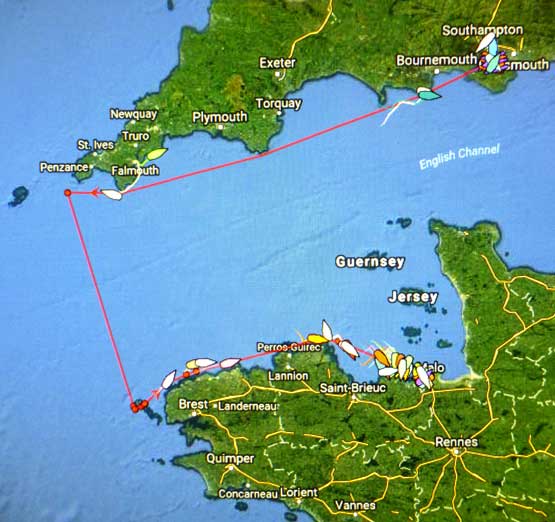 So near and yet so far: the main part of the RORC fleet crowded on the race tracker in light airs off St Malo at 1830 yesterday evening as they struggled to finish the 400-mile race from Cowes via Wolf Rock and Ouessant
So near and yet so far: the main part of the RORC fleet crowded on the race tracker in light airs off St Malo at 1830 yesterday evening as they struggled to finish the 400-mile race from Cowes via Wolf Rock and Ouessant
The vintage Swan 37 Xara (Jonathan Rolls), which had been overall leader at lunchtime Tuesday when she’d been down off Ouessant, finally completed at 3:24 this morning to register 22nd overall, while Silver Shamrock was 24th.
As expected here yesterday, it was Eric de Turckheim’s wonderful A13 Teasing Machine that won overall by a margin of 3 hours and 20 minutes from the German Ker 46 Shakti, a result which, when combined with her second overall in the Volvo Round Ireland back in June, will be making the Machine a challenger for the RORC Points Championship.
It was a good race for northerner Alan Hannon, as Katsu was fifth overall and by taking second in Class 1 astern of Teasing Machine, she was one place better than the First 44.7 Lisa which, under Michael Boyd’s command, was one place ahead of her in the Round Ireland.
Michael Boyd, Commodore of the RORC, was meanwhile racing his new JPK 10.80 Audrey round Ushant, and in a private battle with the third Irish entry, Conor Fogerty’s Sunfast 3600 Bam!, Audrey was to have it by just 20 minutes to make them 9th and 11th overall respectively, while their placings in IRC 3 were 3rd and 4th.
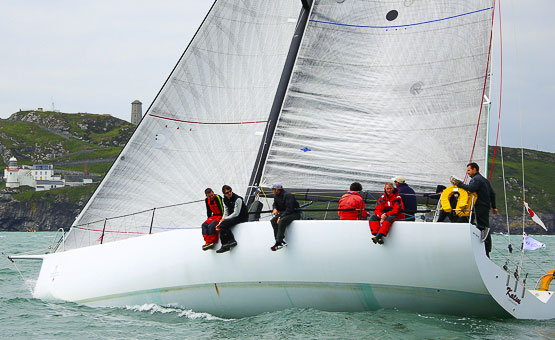 Alan Hannon’s RP 45 Katsu shortly after the start of the Volvo Round Ireland Race at Wicklow in June, when she finished 4th overall
Alan Hannon’s RP 45 Katsu shortly after the start of the Volvo Round Ireland Race at Wicklow in June, when she finished 4th overall
Golden Oldies Shine In RORC’S 400-Mile Race Round Ouessant
#Offshore - Take a classic GRP production-built offshore racer, well matured in years but still in basically good shape, and give her lots of TLC. Add a good wardrobe of new sails and other discretionary go-fast equipment. Then race her regularly with determination and skill, and every so often you’ll find you have a boat which, thanks to a sensibly low rating, can embarrass the new machines when conditions suit, writes W M Nixon.
Thus, in predicting the top ten favourites for the Volvo Round Ireland race in June, we included Richard Loftus’s vintage Swan 65 Desperado. The thinking was that, with strong winds forecast for the long slug along the South Coast, and with the marathon character of the race itself, a hefty big well-sailed classic Swan that provides comfort for her crew would do well in the long run.
Our thinking was right, but we picked the wrong ‘hefty big well-sailed classic Swan’. We should have plumped for Richard Mabley’s Swan 47 Sarabande, a fine boat that won Class 2, and would have done better overall (she was 15th) except that the hyper-calm just north of Rockabill saw her so stopped that she ended up pointing in the wrong direction. When the wind trickled back, it took so long to get steerage way on her again, and pointing towards Wicklow, that lighter zippier boats she’d been pacing with were now on the southern horizon.
In the current and rather intriguing 400-mile RORC Cowes-Wolf Rock-Ouessant-St Malo Race, which started on Sunday 14 August, the manageable sailing, and the regular slowbacks by adverse tide, have seen the low-rated oldies moving up the rankings.
The current overall leader on IRC is Jonathan Rolls Swan 38 Xara, which dates from the early 1970s. But quite how long Xara will remain in that overall lead is doubtful, as she’s currently struggling to round Ouessant while making just 1.7 knots over the ground. And second overall is Eric de Turckheim’s all-conquering A13 Teasing Machine, which is just 68 miles from the finish, and on course at 7.0 knots.
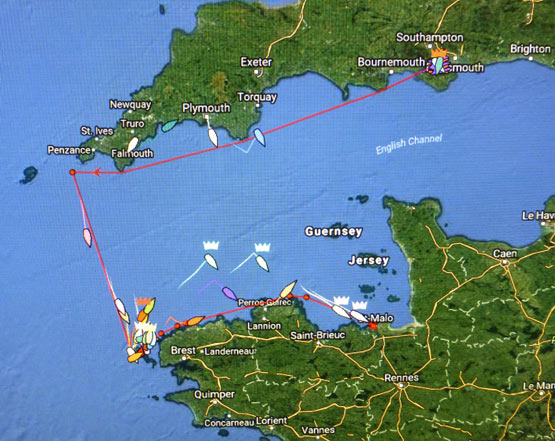 The tracker for the 400-mile RORC Cowes-Wolf Rock-Ouessant-St Malo Race at 1300hrs today (Tuesday)
The tracker for the 400-mile RORC Cowes-Wolf Rock-Ouessant-St Malo Race at 1300hrs today (Tuesday) Lying third is a real blast from the past, the 1976 Half Tonner Silver Shamrock (Stuart Greenfield). Winner of the Half Ton Worlds in 1976 under Harold Cudmore’s command, the 30ft Silver Shamrock (rating just 0.884) is closing in on Ouessant, but making a crisp 5.6 knots.
The three Irish boats in the race are RORC Commodore Michael Boyd’s JPK 10.80 Audrey (currently 14th overall and fifth in IRC 3), Conor Fogerty’s Sunfast 36 Bam (13th overall and fourth in IRC 3), and Alan Hannon’s Reichel Pugh 45 Katsou (17th overall in IRC and second in IRC 1).





























